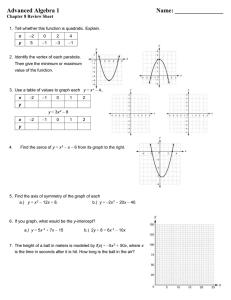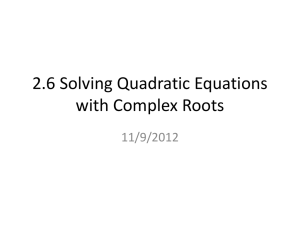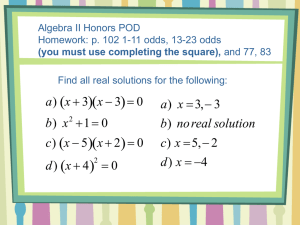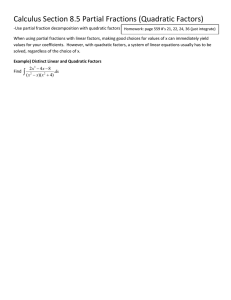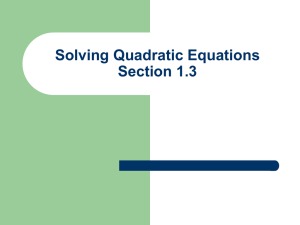Quadratic Equations
advertisement
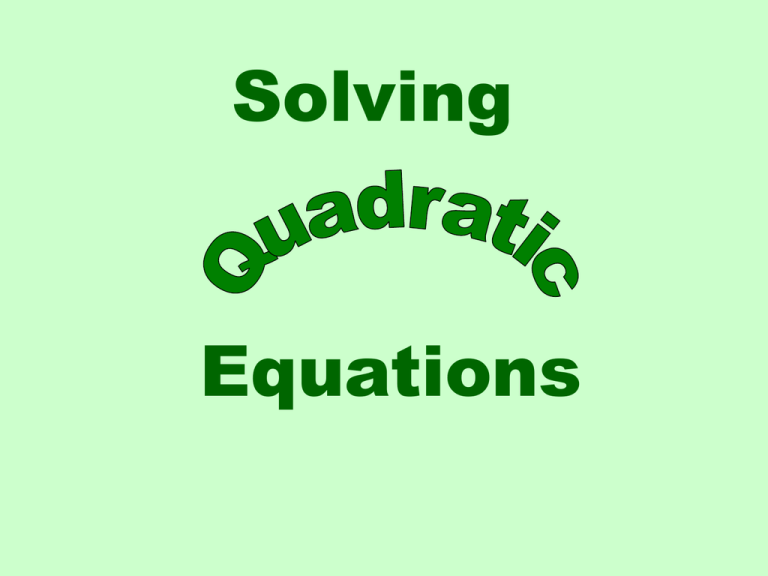
Solving Equations A quadratic equation is an equation equivalent to one of the form ax bx c 0 2 Where a, b, and c are real numbers and a 0 So if we have an equation in x and the highest power is 2, it is quadratic. To solve a quadratic equation we get it in the form above and see if it will factor. x 5x 6 2 -5x + 6 Get form above by subtracting 5x and adding 6 to both sides to get 0 on right side. -5x + 6 x 2 5x 6 0 x 3x 2 0 Factor. Use the Null Factor law and set each factor = 0 and solve. x 3 0 or x 2 0 x3 x2 Remember standard form for a quadratic equation is: 2 2 ax bx 0x c 0 ax c 0 In this form we could have the case where b = 0. When this is the case, we get the x2 alone and then square root both sides. 2x 6 0 Get x2 alone by adding 6 to both sides and then dividing both sides by 2 2 +6 +6 2x 6 2 2 2 x 3 Now take the square root of both sides remembering that you must consider both the positive positiveand and negative root. negative root. x 3 2 Let's check: 2 2 3 6 0 66 0 2 2 3 6 0 66 0 ax bx 0 c0 2 What if in standard form, c = 0? We could factor by pulling an x out of each term. 2 x 3x 0 Factor out the common x x2 x 3 0 Use the Null Factor law and set each factor = 0 and solve. 2 x 0 or 2x 3 0 3 x 0 or x 2 If you put either of these values in for x in the original equation you can see it makes a true statement. ax bx c 0 2 What are we going to do if we have non-zero values for a, b and c but can't factor the left hand side? x 6x 3 0 2 x 6 x 3 2 This will not factor so we will complete the square and apply the square root method. First get the constant term on the other side by subtracting 3 from both sides. 9 3 ___ 9 x 6 x ___ 2 x 6x 9 6 2 Let's add 9. Right now we'll see that it works and then we'll look at how to find it. We are now going to add a number to the left side so it will factor into a perfect square. This means that it will factor into two identical factors. If we add a number to one side of the equation, we need to add it to the other to keep the equation true. x 6x 9 6 2 Now factor the left hand side. x 3x 3 6 x 3 x 3 2 6 Now we'll get rid of the square by square rooting both sides. two identical factors 2 This can be written as: Remember you need both the positive and negative root! 6 x3 6 Subtract 3 from both sides to get x alone. x 3 6 These are the answers in exact form. We can put them in a calculator to get two approximate answers. x 3 6 0.55 x 3 6 5.45 Okay---so this works to solve the equation but how did we know to add 9 to both sides? 9 3 ___ 9 x 6 x ___ 2 x 3x 3 6 +3x +3 x 6x We wanted the left hand side to factor into two identical factors. When you FOIL, the outer terms and the inner terms need to be identical and need to add up to 6x. The last term in the original trinomial will then be the middle the middle term's coefficient divided by 2since andlast squared term's coefficient divided by 2 and squared term times last term will be (3)(3) or 32. So to complete the square, the number to add to both sides is… Let's solve another one by completing the square. 2 x 16 x 2 0 2 2 2 2 To complete the square we want the coefficient of the x2 term to be 1. 2 x 2 8x 1 0 Divide everything by 2 16 1 ___ 16 x 2 8x ___ 8 2 Since it doesn't factor get the constant on the other side ready to complete the square. 2 16 So what do we add to both sides? the middle term's coefficient divided by 2 and squared x 4x 4 x 42 15 2 x 4 15 x 4 15 Factor the left hand side Square root both sides (remember ) Add 4 to both sides to get x alone x 4 15 By completing the square on a general quadratic equation in standard form we come up with what is called the quadratic formula. (Remember the song!! ) ax bx c 0 2 b b 2 4ac x 2a This formula can be used to solve any quadratic equation whether it factors or not. If it factors, it is generally easier to factor---but this formula would give you the solutions as well. 1x 2 6x 3 0 We solved this by completing the square but let's solve it using the quadratic formula 6 36 12 (1) (3) b6 b6 2 4ac x 2 2a(1) Don't make a mistake with order of operations! Let's do the power and the multiplying first. 24 4 6 2 6 6 36 12 6 24 6 2 6 x 2 2 2 2 3 6 2 There's a 2 in common in the terms of the numerator 3 6 These are the solutions we got when we completed the square on this problem. NOTE: When using this formula if you've simplified under the radical and end up with a negative, there are no real solutions. (There are complex (imaginary) solutions, but that will be dealt with in year 12 Calculus). SUMMARY OF SOLVING QUADRATIC EQUATIONS • Get the equation in standard form: ax bx c 0 2 • If there is no middle term (b = 0) then get the x2 alone and square root both sides (if you get a negative under the square root there are no real solutions). • If there is no constant term (c = 0) then factor out the common x and use the null factor law to solve (set each factor = 0). • If a, b and c are non-zero, see if you can factor and use the null factor law to solve. • If it doesn't factor or is hard to factor, use the quadratic formula to solve (if you get a negative under the square root there are no real solutions). This "discriminates" or tells us what type of solutions we'll have. ax bx c 0 2 b b 4ac x 2a 2 If we have a quadratic equation and are considering solutions from the real number system, using the quadratic formula, one of three things can happen. 1. The "stuff" under the square root can be positive and we'd get two unequal real solutions if b 2 4ac 0 2. The "stuff" under the square root can be zero and we'd get one solution (called a repeated or double root because it would factor 2 if b 4us acthe 0same solution). into two equal factors, each giving 3. The "stuff" under the square root can be negative and we'd get no real solutions. if b 2 4ac 0 The "stuff" under the square root is called the discriminant. The Discriminant b 2 4ac Acknowledgement I wish to thank Shawna Haider from Salt Lake Community College, Utah USA for her hard work in creating this PowerPoint. www.slcc.edu Shawna has kindly given permission for this resource to be downloaded from www.mathxtc.com and for it to be modified to suit the Western Australian Mathematics Curriculum. Stephen Corcoran Head of Mathematics St Stephen’s School – Carramar www.ststephens.wa.edu.au

